|
|
|
Sort Order |
|
|
|
Items / Page
|
|
|
|
|
|
|
| Srl | Item |
| 1 |
ID:
181856
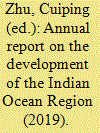

|
|
|
|
|
| Publication |
Singapore, Springer Nature, 2021.
|
| Description |
vi, 298p.hbk
|
| Series |
Research Series on the Chinese Dream and China's Development Path
|
| Standard Number |
9789811619816
|
|
|
|
|
|
|
|
|
|
|
|
Copies: C:1/I:0,R:0,Q:0
Circulation
| Accession# | Call# | Current Location | Status | Policy | Location |
| 060093 | 330.91824/ZHU 060093 | Main | On Shelf | General | |
|
|
|
|
| 2 |
ID:
165536
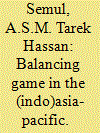

|
|
|
|
|
| Summary/Abstract |
The (re)emergence of China and the relative decline of the power of the United States (US) as the unipolar super power has shifted the geostrategic centre of gravity towards the Asia-Pacific region, also known in its extended form as Indo- Pacific region. Multiple new and frozen flashpoints have emerged in this region as China is increasingly seeking to tilt the power balance in its favour and the US is growing doubtful and impatient regarding the Chinese intentions. To mitigate the China threat, the US has already rebalanced its foreign policy under the Obama administration from the Middle East to the Pacific and current President Trump has extended the geographical reach of his new grand strategy of Free and Open Indo-Pacific to bring the Indian Ocean into play. One of the most predominant discourses that tries to explain this emerging great power relation and power transition is the ‘Thucydides Trap’. This discourse maintains a binary understanding that in a bipolar setting, the rise and decline of great powers make war inevitable. However, this oversimplified assumption may lead to a limited understanding of a region which has emerged with the support of the liberal order and slowly replacing the West as the epicentre of economic progress. This paper argues that there are ‘other discourses’ where middle and smaller regional powers not necessarily stranded between great power rivalry, rather they renegotiate the order in the (Indo)Asia-Pacific region to create multipolarity. On the contrary, the interdependence of the US and China in a globalized world compels the great powers to find ways to keep peace in the troubled waters of the Indo-Pacific. To find out to what extent all these discourses are intertwined and influence each other is another objective of this paper.
|
|
|
|
|
|
|
|
|
|
|
|
|
|
|
|
| 3 |
ID:
167170
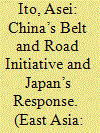

|
|
|
|
|
| Summary/Abstract |
China’s “Belt and Road Initiative (BRI)” has been gaining attention, but the evaluation of the scheme is still unsettled due to its multifaceted nature. This paper examines the basic characteristics of the initiative, disaggregates the initiative into separate dimensions, and traces Japan’s responses toward BRI from 2013 to 2018. From 2013 to 2015, the Japanese government and the Diets committee have discussed the Asian Infrastructure Investment Bank (AIIB) membership issue intensively. Only after 2015, the discussion covered the BRI, wider topics. By looking at responses by the Japanese government, the initial response until 2016 was “non-participation;” however, after 2017, the government has shifted attitude to “conditional engagement” through business cooperation in the third countries especially plus-sum dimension. Such a shift has been backed by a concurrent risk-hedging approach represented by the Indo-Pacific strategy.
|
|
|
|
|
|
|
|
|
|
|
|
|
|
|
|
| 4 |
ID:
174404
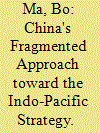

|
|
|
|
|
| Summary/Abstract |
Since the Trump administration endorsed the concept of Indo-Pacific in 2017 and later rolled out a US Indo-Pacific strategy, the Chinese government and China's academic and policy community have maintained a high interest in understanding the strategy in terms of its conception and substance. However, Chinese officials and scholars have been divided in assessing the nature, purposes, and impacts of the strategy and have reached no consensus on policy responses. This fragmentation has appeared before, as we have seen among international law scholars on some thorny international law issues. This article argues that the larger the scale of the issue, the higher the degree of fragmentation is likely to be in China's policy and academic community. The US Indo-Pacific strategy is a good example of that parallel and vertical fragmentation. Chinese scholars, coming from different academic backgrounds, have offered different assessments and recommendations on the Indo-Pacific strategy, which have made the policy debate in today's China quite vibrant and sophisticated.
|
|
|
|
|
|
|
|
|
|
|
|
|
|
|
|
| 5 |
ID:
176239
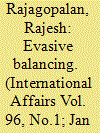

|
|
|
|
|
| Summary/Abstract |
India has adopted the Indo-Pacific concept with uncharacteristic speed. This article examines India's Indo-Pacific strategy, which evolved out of its earlier ‘Look East’ and ‘Act East’ policies but is much more focused on strategic concerns than on trade or connectivity. As such, the strategy is subset of its China policy, and includes contradictory elements of balancing China by building partnerships with the United States as well as with regional powers, while simultaneously pursuing a reassurance strategy to convince Beijing that India is not really balancing China. The combination of these contradictory elements is characterized as evasive balancing, which is a more useful concept than either pure balancing or hedging for understanding the policies of India and of many other countries in the region that are trying to manage China's rise. However, reassurance strategies rarely work and the combination of balancing and reassurance is even less likely to be viable.
|
|
|
|
|
|
|
|
|
|
|
|
|
|
|
|
| 6 |
ID:
190075
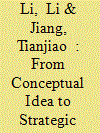

|
|
|
|
|
| Summary/Abstract |
Chinese scholars’ research on “Indo-Pacific Strategy” has undergone two shifts. Firstly, they began to pay limited attention to the Indo-Pacific concept and the US Indo-Pacific regional strategy in 2013. With 2017 and 2018 as the turning point, the attention to the Indo-Pacific strategy shows a significant increase. Secondly, regarding the scholars’ judgment of the Indo-Pacific strategy, since the end of 2019, they reach a consensus on their assessment of the strategy, especially on its threat to China. The two main reasons that drove the above shifts were the enrichment of the Indo-Pacific Strategy by the United States and China’s perception of India’s attitudes. China’s official responses to the strategy have shown a co-moving rhythm with scholars’ research, shifting from a more open and neutral attitude toward the concept to a critical one. Against the background of America’s continuing effort to implement the Indo-Pacific strategy, China’s policy responses can focus on three aspects: do a good job of itself, handle China-US relations peacefully and cooperatively, and break down the group politics.
|
|
|
|
|
|
|
|
|
|
|
|
|
|
|
|
| 7 |
ID:
190370
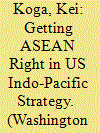

|
|
|
|
|
| Summary/Abstract |
As part of the intensifying great power competition between the United States and China, a set of new Indo-Pacific frameworks primarily led by Washington—namely the Quadrilateral Security Dialogue (Quad), the AUKUS, and the Indo-Pacific Economic Framework for Prosperity (IPEF)—has emerged. These US-centric minilateral and multilateral frameworks essentially aim to build a coalition with politically and strategically “like-minded” states to maintain and enhance the existing rules-based international order largely constructed by the West since the end of the Cold War.
|
|
|
|
|
|
|
|
|
|
|
|
|
|
|
|
| 8 |
ID:
163992
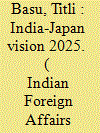

|
|
|
| 9 |
ID:
193416


|
|
|
| 10 |
ID:
142126
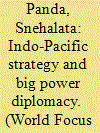

|
|
|
|
|
| Summary/Abstract |
India’s presence in the IO is limited though it has numerous trade routes favouring maritime trade for a number of countries. But over the years it is used in a manner adversarial to India’s interests. China has connected with more littorals in the Ocean and cautioned India against considering it as its “backyard”. Chinese sources deny its expansionist objective in the IOR. But India should not be complacent, rather it should improve its activities in the region for ensuring stability in the environment to expedite socio economic development.
|
|
|
|
|
|
|
|
|
|
|
|
|
|
|
|
| 11 |
ID:
178700
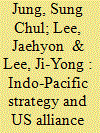

|
|
|
|
|
| Summary/Abstract |
Will the US-led Indo-Pacific strategy lead to an extensive alliance network against China? This article shifts focus to non-Quad Asian states—in particular, Indonesia, Vietnam, and South Korea—that face a strategic dilemma in the US-China competition and examines their positions regarding a rising China and the Indo-Pacific strategy. While reluctant to join the US strategy for the Indo-Pacific region, Asian middle powers now aim to tame, rather than contain, China despite their slight variations of response to the Indo-Pacific strategy. The US and its three partners—Japan, India, and Australia—have not been successful yet in recruiting new members to their coalition, mainly because of the declining hegemon’s (seemingly) weakened commitment to a liberal international order and the rising challenger’s (potential) opposition and punishment.
|
|
|
|
|
|
|
|
|
|
|
|
|
|
|
|
| 12 |
ID:
176240
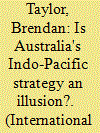

|
|
|
|
|
| Summary/Abstract |
Australia has been among the most prominent advocates of the increasingly popular Indo-Pacific concept. This article argues that Canberra's enthusiasm for the concept stems from its appeal to the two dominant traditions of Australian foreign policy—a ‘dependent ally’ tradition and a ‘middle power’ approach. While these two traditions are typically seen as being in tension, the Indo-Pacific concept provides a rare point of convergence between them. The article begins by outlining the appeal of the Indo-Pacific concept to each of these traditions. Using a case-study of recent Australian policy toward the South China Sea disputes, however, the article then demonstrates that Australia has in practice implemented its stated Indo-Pacific strategy far less consistently than its very vocal support would appear to suggest. This disjuncture is attributed to the growing influence of a third, generally understudied, ‘pragmatic’ Australian foreign policy tradition. Because Australia has been such a prominent champion of the Indo-Pacific concept, the article concludes that this divergence between the rhetoric and the reality of Australia's Indo-Pacific strategy threatens to have a negative impact on the concept's broader international appeal and sustainability, particularly among Australia's south-east Asian neighbours.
|
|
|
|
|
|
|
|
|
|
|
|
|
|
|
|
| 13 |
ID:
160484
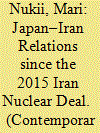

|
|
|
|
|
| Summary/Abstract |
The US–Japan alliance has been one of the most important elements in configuring Japanese diplomacy since World War II. Accordingly, Japan’s relations with Iran always require striking a delicate balance among Japan’s security policy based on the US–Japan alliance, its energy demands, and its historically good bilateral relations with Iran. Japan welcomed the nuclear deal between Iran and the P5+1 group of nations in 2015. Iran holds the world’s second largest natural gas reserves and ranks fourth in proven crude oil reserves. Japanese companies were eager to re-enter the Iranian market with its rich natural resources and over 80 million strong population. However, the inauguration of President Trump in January 2017 and his antagonistic stance toward Iran has slowed this move. The Japanese government has taken the initiative to improve relations with Iran after lifting its sanctions against that country, while trying to mitigate possible risks. This article aims to examine relations between Iran and Japan after the Iran nuclear deal from three aspects: economic relations, nuclear cooperation, and security.
|
|
|
|
|
|
|
|
|
|
|
|
|
|
|
|
| 14 |
ID:
185767
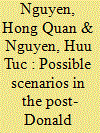

|
|
|
|
|
| Summary/Abstract |
In 2017 US President Donald Trump announced the Free and Open Indo-Pacific (FOIP) strategy to replace the “rebalance” strategy of the predecessor Obama administration. After nearly four years in implementation, the question is, can strategy be continued under the incumbent President Joe Biden? The article carries out an analysis of a number of influencing factors and gives three distinct possible scenarios for US Strategy in the coming times which range from cooperation, ambivalence, and competition. The authors argue that this strategy will be maintained despite some changes in accordance with the domestic and foreign direction of the new Administration.
|
|
|
|
|
|
|
|
|
|
|
|
|
|
|
|
| 15 |
ID:
181258


|
|
|
|
|
| Summary/Abstract |
Manqing Cheng comments on the origins and development of the emerging Indo-Pacific security architecture.
|
|
|
|
|
|
|
|
|
|
|
|
|
|
|
|
| 16 |
ID:
189328
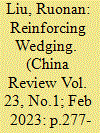

|
|
|
|
|
| Summary/Abstract |
From the Asian financial crisis in 1997 to the year 2010, China's self-restraint and strategic reassurance toward ASEAN countries created a favorable regional environment for its rise. After 2010, the South China Sea disputes and the Sino-U.S. strategic competition intensified. During this period, China simultaneously pursue a wedging strategy which aims to avoid Southeast Asia completely turning toward the United States. Since the Trump administration launched the Indo-Pacific strategy, Sino-U.S. relations have transited from competition to confrontation, significantly increasing the importance of Southeast Asia as a buffer between China and the U.S. At the same time, intensified economic dependence on China for ASEAN countries, and the uncertainty surrounding the U.S.'s strategic attention to the region have increased the costs and risks of alienating China. Both China and ASEAN countries can no longer afford further deterioration in their relations. In the context of the Indo-Pacific strategy, the primary goal of China's Southeast Asia policy is to reduce ASEAN countries' willingness and ability to rely on external powers to exert pressure on it, while strengthening the region's function as a bridge to the global industrial chain and undermining the legitimacy of the Indo-Pacific strategy through advocating ASEAN-led multilateralism. China's Southeast Asia policy effectiveness depends on Beijing's ability to alleviate the internal dilemma within its policy goal, which has been intensified by the Indo-Pacific Strategy. Currently, the Indo-Pacific Strategy has gained some support in Southeast Asia and has weakened the regional countries' domestic support for pro-China policy. Future challenges in China's relations with ASEAN countries do not depend exclusively on the dynamics of the Sino-U.S. relations, given that domestic political changes in key regional countries are closely tied to China's relations with the region.
|
|
|
|
|
|
|
|
|
|
|
|
|
|
|
|
| 17 |
ID:
173694
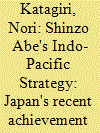

|
|
|
|
|
| Summary/Abstract |
I use IR theories to investigate Japanese foreign policy between 2012 and 2017. I make two arguments. First, I argue that the best theoretical combination to explain Japanese foreign policy under Abe is one of defensive realism and liberalism, with focus on the economic aspects of regional partnerships. Japan has followed a traditional realist approach in security policy, but he has adopted a more activist and broader economic vision in his approach. Second, this analysis reflects Japan’s expansive search of strategic allies in Southeast Asia and beyond; behind the security rivalry and economic partnership with China is the emergence of a geographically wider security architecture coupled with robust economic networks in Southeast Asia and South Asia. In effect, the Abe government has increased ties with India through trade and investment, and reinvigorated the existing diplomatic effort with Southeast and South Asia in a comprehensive package of security and economic initiative.
|
|
|
|
|
|
|
|
|
|
|
|
|
|
|
|
| 18 |
ID:
192513
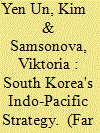

|
|
|
|
|
| Summary/Abstract |
The US Indo-Pacific Strategy, whose main principles were formulated in the US National Security Strategy released in December 2017, is aimed at preserving a unipolar structure of the world in an era of global changes that undermine US claims to world dominance. The more the authority of the unipolar world's overlord is undermined, the more diverse and dangerous the overlord's attempts become to preserve its dominant role by drawing into its orbit the countries that previously took a neutral stance toward the unilateralists' activity. This paper analyzes South Korean policy regarding the Indo-Pacific Strategy and examines the policy's political and economic aspects. The authors proceed from the view that South Korea, which has remained within the American global influence system for many decades, cannot ignore practically any American initiative. At the same time, the authors express doubt about the possibility of the transformation of the Indo-Pacific bloc being created under the auspices of the US into a significant international structure capable of altering the vector of the ongoing global changes. Moreover, the Indo-Pacific Initiative of the
|
|
|
|
|
|
|
|
|
|
|
|
|
|
|
|
| 19 |
ID:
174737
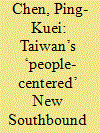

|
|
|
|
|
| Summary/Abstract |
Taiwan’s relations with South and Southeast Asia have become the focus of scholarly discussion since it proposed the New Southbound Policy (NSP) in 2016. Few touch on the NSP’s effect on Taiwan’s relations with countries outside the NSP targets. This paper argues that the NSP has a positive effect on US–Taiwan relations. The people-centered approach of the NSP helps the Taiwanese government create a credible commitment to a moderate foreign policy. It signals Taiwan’s resolve to uphold the US interests in Taiwan Strait. Taiwan’s policy direction has received the US’s approval, resulting in cordial US–Taiwan relations. The public supports from the US have strengthened Taiwan’s confidence under tense cross-Strait relations. Recently, the US’s Indo-Pacific strategy provides Taiwan an opportunity to establish a closer tie with the US. But the prospect of bilateral cooperation in the Indo-Pacific region depends on a clear proposal.
|
|
|
|
|
|
|
|
|
|
|
|
|
|
|
|
| 20 |
ID:
189254
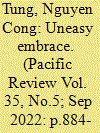

|
|
|
|
|
| Summary/Abstract |
Like many other small and middle powers, Vietnam is facing a strategic dilemma in the face of the U.S.-China rivalry. With the introduction of a vision for Free and Open Indo-Pacific (FOIP), the US seeks to strengthen ties with its allies and partners in the region to preserve rules-based international order and to counter China’s rise. Being positioned as the U.S. burgeoning like-minded partner in the regional security architecture, how Vietnam responds to the FOIP strategy, hence, merits consideration. This article argues that Vietnam has responded positively toward the FOIP strategy due to the high compatibility between some key tenets of this strategy and its national interests. However, rather than joining and supporting FOIP in a full-fledged way, Vietnam has chosen to work selectively in some issues with the US. More specifically, while Vietnam proactively embraces the economic dimension in FOIP, it still remains cautious about the security domain. The rationale behind Vietnam’s hesitation to lend full support to this strategy is partially driven by China factor. In this article, China is addressed as a “brake,” which can exert influence on the speed and scope of cooperation that Vietnam is willing to move forward with the US under FOIP strategy.
|
|
|
|
|
|
|
|
|
|
|
|
|
|
|
|
|
|
|
|
|